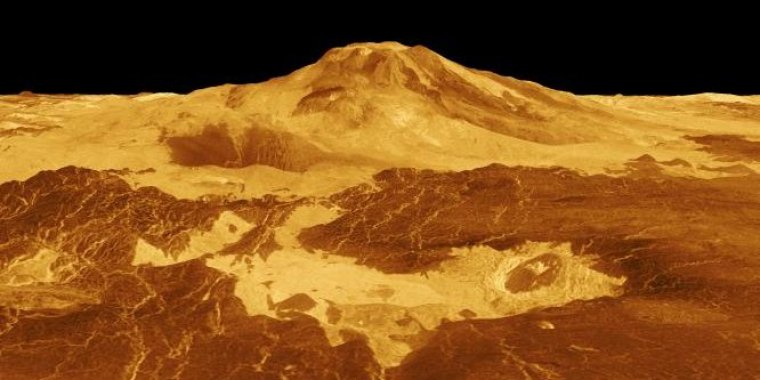| News / Science News |
Massive Volcanism May Have Altered Ancient Venus’ Climate
Volcanic activity lasting hundreds to thousands of centuries and erupting massive amounts of material may have helped transform Venus from a temperate and wet world to the acidic hothouse it is today, a NASA paper suggests.

Maat Mons is displayed in this computer-generated, three-dimensional perspective of the surface of Venus. The viewpoint is located 634 kilometers (393 miles) north of Maat Mons at an elevation of 3 kilometers (2 miles) above the terrain. Lava flows extend for hundreds of kilometers across the fractured plains shown in the foreground, to the base of Maat Mons. NASA Magellan mission synthetic aperture radar data is combined with radar altimetry to develop a three-dimensional map of the surface. The vertical scale in this perspective has been exaggerated 10 times. Photo: NASA/JPL
The paper also discusses these “large igneous provinces” in Earth’s history which caused several mass extinctions on our own planet millions of years ago.
“By understanding the record of large igneous provinces on Earth and Venus, we can determine if these events may have caused Venus’ present condition,” said Dr. Michael J. Way, of NASA’s Goddard Institute for Space Studies in New York.
Large igneous provinces are the products of periods of large-scale volcanism lasting tens of thousands or even hundreds of thousands of years. They can deposit more than 100,000 cubic miles of volcanic rock onto the surface.
Venus today boasts surface temperatures of around 864 F on average, and an atmosphere 90 times the surface pressure of Earth’s. According to the study, these massive volcanic outpourings may have initiated these conditions sometime in Venus’ ancient history.
In particular, the occurrence of several such eruptions in a short span of geologic time (within a million years) could have led to a runaway greenhouse effect which kicked off the planet’s transition from wet and temperate to hot and dry.
Large fields of solidified volcanic rock cover 80% of Venus’ surface in total, Way said. “While we’re not yet sure how often the events which created these fields occurred, we should be able to narrow it down by studying Earth’s own history.”
Life on Earth has endured at least five major mass extinction events since the origin of multicellular life about 540 million years ago, each of which wiped out more than 50% of animal life across the planet.
According to this study and others before it, the majority of these extinction events were caused or exacerbated by the kinds of eruptions that produce large igneous provinces.
In Earth’s case, the climate disruptions from these events were not sufficient to cause a runaway greenhouse effect as they were on Venus, for reasons that Way and other scientists are still working to determine.
NASA’s next missions to Venus, scheduled for launch in the late 2020s – the Deep Atmosphere Venus Investigation of Noble gases, Chemistry, and Imaging (DAVINCI) mission and the Venus Emissivity, Radio science, InSAR, Topography, And Spectroscopy (VERITAS) mission – aim to study the origin, history, and present state of Venus in unprecedented detail. (NASA)
YOU MAY ALSO LIKE





